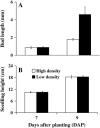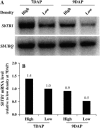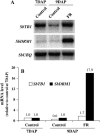Phytochrome B represses Teosinte Branched1 expression and induces sorghum axillary bud outgrowth in response to light signals
- PMID: 16443694
- PMCID: PMC1400571
- DOI: 10.1104/pp.105.074856
Phytochrome B represses Teosinte Branched1 expression and induces sorghum axillary bud outgrowth in response to light signals
Abstract
Light is one of the environmental signals that regulate the development of shoot architecture. Molecular mechanisms regulating shoot branching by light signals have not been investigated in detail. Analyses of light signaling mutants defective in branching provide insight into the molecular events associated with the phenomenon. It is well documented that phytochrome B (phyB) mutant plants display constitutive shade avoidance responses, including increased plant height and enhanced apical dominance. We investigated the phyB-1 mutant sorghum (Sorghum bicolor) and analyzed the expression of the sorghum Teosinte Branched1 gene (SbTB1), which encodes a putative transcription factor that suppresses bud outgrowth, and the sorghum dormancy-associated gene (SbDRM1), a marker of bud dormancy. Buds are formed in the leaf axils of phyB-1; however, they enter into dormancy soon after their formation. The dormant state of phyB-1 buds is confirmed by the high level of expression of the SbDRM1 gene. The level of SbTB1 mRNA is higher in the buds of phyB-1 compared to wild type, suggesting that phyB mediates the growth of axillary shoots in response to light signals in part by regulating the mRNA abundance of SbTB1. These results are confirmed by growing wild-type seedlings with supplemental far-red light that induces shade avoidance responses. We hypothesize that active phyB (Pfr) suppresses the expression of the SbTB1 gene, thereby inducing bud outgrowth, whereas environmental conditions that inactivate phyB allow increased expression of SbTB1, thereby suppressing bud outgrowth.
Figures











References
-
- Booker J, Sieberer T, Wright W, Williamson L, Willett B, Stirnberg P, Turnbull C, Srinivasan M, Goddard P, Leyser O (2005) MAX1 encodes a cytochrome P450 family member that acts downstream of MAX3/MAX4 to produce a carotenoid-derived branch-inhibiting hormone. Dev Cell 8: 443–449 - PubMed
-
- Casal JJ, Sanchez RA, Deregibus VA (1986) The effect of plant density on tillering: the involvement of R/FR ratio and the proportion of radiation intercepted per plant. Environ Exp Bot 26: 365–371
Publication types
MeSH terms
Substances
Associated data
- Actions
- Actions
LinkOut - more resources
Full Text Sources
Other Literature Sources

